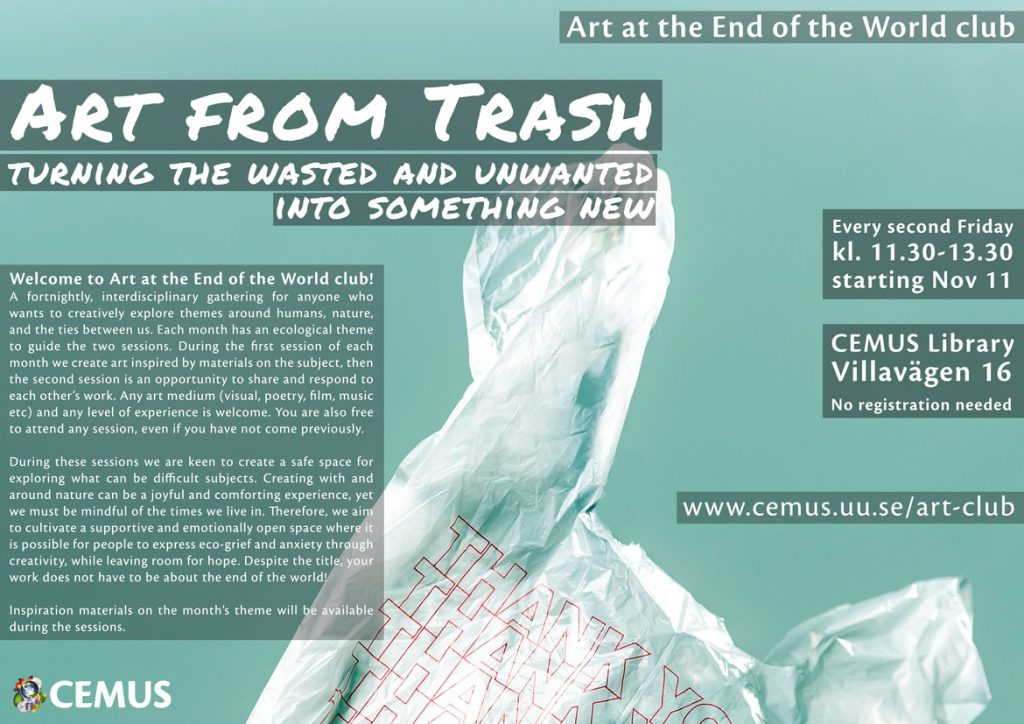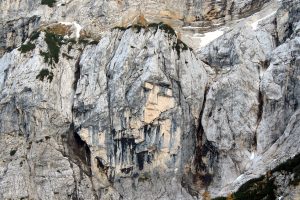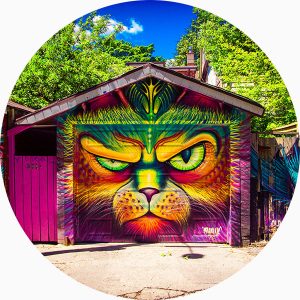
Welcome to Art at the End of the World club!
When: Every second Friday, kl. 11.30-13.30
Where: CEMUS Library, Geocentrum, Villavägen 16
No registration needed
More information: contact enki.simmons[a]cemus.uu.se
Welcome to Art at the End of the World club! A fortnightly, interdisciplinary gathering for anyone who wants to creatively explore humans-with-nature in our changing (ending?) world. Each month has an ecological theme to guide the two sessions. During sessions we create art inspired by materials on the subject, then we share and respond to each other’s work. Any art medium (visual, poetry, film, music etc) and any level of experience is welcome. You are also free to attend any session, even if you have not come previously, and do not need to be present for the whole session. We provide some basic visual art equipment, but please bring any specialist items you may want.
During these sessions we are keen to create a safe space for exploring what can be difficult subjects. Creating with and around nature can be a joyful and comforting experience, yet we must be mindful of the times we live in. Therefore, we aim to cultivate a supportive and emotionally open space where it is possible for people to express eco-grief and anxiety through creativity, while leaving room for hope. Despite the title, your work does not have to be about the end of the world!
May 23rd
On the Edge of Nature
Welcome to the ‘Art at the End of the World club’, with the last theme of this semester.
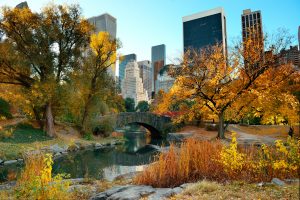
Designed by Freepik www.freepik.com
During this month, we will challenge our creative fingers to scan the edges of nature and philosophize if nature has a start and end and where that could be. Is there a clear line between natural and unnatural? When is a landscape (un)natural? In the search of living in a world where natural landscapes are rapidly disappearing, we can feel lost, angry, and confused. Are we still nature after all? Today, we will stand still, create, and listen. And maybe this will bring us a little closer to the meaning of it all.
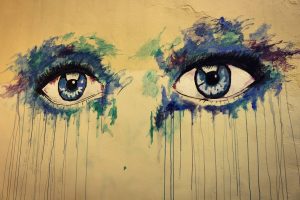
March 1st & 15th
Nature eyes upon us
Welcome at the Art at the End of the World club!
We humans have become more and more isolated from nature. Defining and seeing it as something outside of ourselves. Nature became something we can use for resources, adventures, or quiet time when we need it. A one-directional conversation. Turning this perspective around, how would nature see us? What would it think? This month we will explore natures eyes upon us, using art as a lens through which nature looks at us. We will ask ourselves the question, how can nature communicate with us? And maybe more importantly, are we listening?
Inspirational material:
- TERRA (2015) documentary: https://www.youtube.com/watch?v=hdK7Ip7-mIY *Synopsis: A visually stunning documentary that reflects human’s relationship to other species on Earth as humanity becomes more and more isolated from Nature.
- A letter from mother earth to humans. https://whatcanyoudo.earth/mother-earths-blog/letter-from-mother-earth/ https://medium.com/greener-together/a-heartfelt-letter-from-mother-earth-to-humanity-508334571ae8
- Looking through natures eyes- Art work. https://www.iaacblog.com/programs/looking-natures-eyes/ Virtual reality. Literally through the eyes of nature. https://www.designboom.com/art/marshmallow-laser-feast-grizedale-forest-in-the-eyes-of-the-animal-01-02-2015/ and https://www.youtube.com/watch?v=gfyuuo1LwCE
Feb 2nd & Feb 16th
The art of dreaming
Vincent Van Gogh’s The Starry Night (1889).
‘If it’s good to live, then it’s better to be asleep dreaming, and best of all, mother, is to awake.’
‘Proverbs and Songs XXIX’ by Antonio Machado.
In times of the climate crisis, it can keep us awake at night, hindering our ability to dream. What about the dreams we experience? And how do they look? Can they be expressed through art? During the next two sessions, we will delve into our dreams and what they mean to us. We will ask ourselves how we can relate to dreams during environmental challenges.
Where do we go when we fall asleep? Where does our journey take us? There are different types of dreams, including daydreams, lucid dreams, healing dreams, vivid dreams, nightmares, and more! Many artists have touched upon this theme throughout history: writers such as Antonio Machado and Allan Poe, painters like Frida Kahlo and Salvador Dalí, along with the founder of psychoanalysis, Sigmund Freud, among other artists, expressed that dreams hold the same importance as real life.
Do we still dare to dream?
Inspirational materials:
- Dreams by Edgar Allan Poe – Poems | Academy of American Poets. Available at: https://poets.org/poem/dreams-0
- Fiore, J. (2019). Art History’s Iconic Depictions of Dreams, from the Renaissance to Surrealism. Available at: https://www.artsy.net/article/artsy-editorial-art-historys-iconic-depictions-dreams-renaissance-surrealism
- Last Night As I Was Sleeping by Antonio Machado. Available at: https://allpoetry.com/Last-Night-As-I-Was-Sleeping
- ‘Proverbs and Songs’ by Antonio Machado. Words for the Year. Available at: https://wordsfortheyear.com/2020/06/17/proverbs-and-songs-by-antonio-machado/
- Social Dreaming Climate Change (2018) Cape Farewell. Available at: https://www.capefarewell.com/social-dreaming-climate-change/
- Stalpaert, C. (2023) Performing Arts Activating Climate Change Awareness: Hyphenated Thinking in Common Dreams — Flotation School. Link to the article at uppsala university library.
- The Climate Dreams Project. (2023). The Climate Dreams Project. Available at: https://climatedreams.com/
26th January until end of February
Art at the End of the World: Exhibition
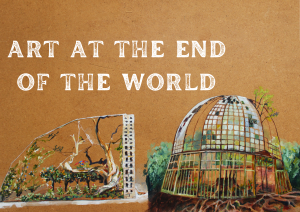
Welcome to an interactive exhibition exploring humans-with-nature in a changing climate.
Sometimes it feels like the world is ending. Or at least, a world is ending. Or the world as we know it. Or the story of the world as some people know it…
Join us as we ask, what does it mean to engage in the act of creation as we face apocalypse? Crises? Extinctions? As ends herald beginnings, what art and life can we find in the ruins?
On display are pieces created by attendees of Art at the End of the World club. Coming from a variety of backgrounds, the artists have created works that range from poetry to painting to multi-medium experiences.
Location: CEMUS library and work lounge, Geocentrum Villavägen 16
Opening event: Fri 26 Jan, 16.00 with fika. On display until end of February.
Featured artwork: Francis Emlyn Rogers
Dec 8th & Jan 19th
Stories in the Ice
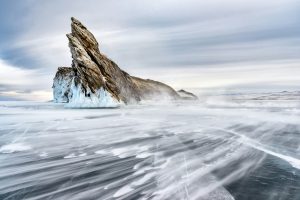 Ice has become a central narrative of climate change. We hear scientists talk about it all the time: receding ice sheets, melting glaciers, and the rising sea levels that come as a result. Or perhaps friends and family have told us memories of ice skating on lakes and ponds that never freeze anymore, or mountains that no longer see snow. But what about the ice itself? Still and silent, creaking and crashing, ancient and fresh, ice has many of its own stories to tell.
Ice has become a central narrative of climate change. We hear scientists talk about it all the time: receding ice sheets, melting glaciers, and the rising sea levels that come as a result. Or perhaps friends and family have told us memories of ice skating on lakes and ponds that never freeze anymore, or mountains that no longer see snow. But what about the ice itself? Still and silent, creaking and crashing, ancient and fresh, ice has many of its own stories to tell.
Inspirational materials:
- Library of Ice by Naomi Campbell (non-fiction, autobiography, travel writing. Available in UU library)
- The Singing Glaciers of Svalbard by Sam Kinchin-Smith (essay)
- Ice Watch by Olafur Eliasson (land art, sculpture)
- Candle Ice by Carmen Braden (sound art, music)
- Evaporation by Jana Winderen (sound art)
- Antarctica the Woman by Stephanie Krzywonos (essay)
- Voice of the Iceberg by Joseph Michael (audio documentary)
Nov 10th & Nov 24th
Rooting in Place

“It is the peculiar value of art, that it is the medium in which man and landscape, form and world, meet and find one another.” – Rainer Maria Rilke
Art club members take us to meet their favourite places in Uppsala! Inspired by the environmental arts education of Jan van Boeckel, we will respond and root with the more-than-human beings we find in place.
10th Nov 12.00-14.00 Malma Äng – a biodiverse meadow with great value to the local community, here we will explore our natural senses and themes of protection. Meet at the Rädda Malma sign, found by the bus stop Uppsala Barkspadevägen (on Slädvägen, 756 47) Note different time!
Update! There will be an extra session at Malma on Saturday 18th, 12-14
24th Nov 11.30-13.30: Ekeby Pölen – a quiet pond and fields with community gardening nearby, here we will imagine the voices of the plants, stones, and waters. Meet at Uppsala Säves väg bus stop (on Flogstavägen, 752 63)
Inspirational materials:
These artworks will not be presented during the sessions, but may serve as inspiration prior to attending as artists who have responded directly to a place.
- ORDA – This is My Land by Sofia Jannock (music album)
- Superioryouareinferior by Rae Spoon (music album)
- Rivers and Tides by Andy Goldsworthy (short film, land art)
- Luminous Earth Grid by Stuart Williams (land art)
Oct 13th & Oct 27th
Art at the End of (a) (the) World(s)
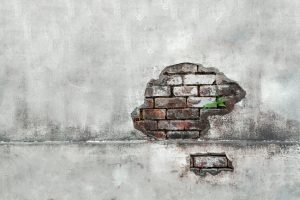
Sometimes it feels like the world is ending. Or at least, a world is ending. Or the world as we know it. Or the story of the world as some people know it…
This month, Art at the End of the World club returns to its central theme. What does it mean to engage in the act of creation as we face apocalypse? Crises? Extinctions? As ends herald beginnings, we ask ourselves – what art and life can we find in the ruins?
Inspirational materials:
- Living as a Human Being in the End of the World by Jenni Laiti
- Dark Mountain manifesto
- At Work in the Ruins by Dougald Hines (copy available in CEMUS library)
- BBQ & Apocalpyse (short film)
- Dear 2100, – CEMUS students (copies available in CEMUS library)
May 12th & June 4th
Arts of Living on a Damaged Planet
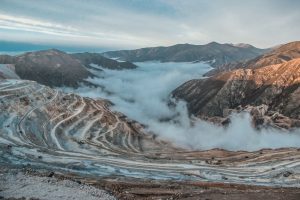
In our penultimate session of the year we will explore what it means to live on a planet that is both damaged and beautiful.
April 21 & May 5
Deep Listening
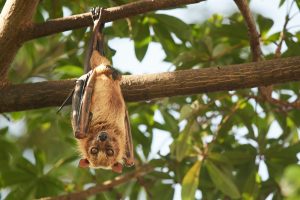
What if you could hear like a bat zipping and swooping around the night sky, or a whale sounding the depths of the oceans, or elephants sounding the earth? Based on the philosophy and works of composer Pauline Oliveros, join us in exploring the possibilities of Deep Listening. As climate change and war radically and rapidly reshape our world, Deep Listening is an urgent tool for reaching a heightened state of awareness and connecting to all that there is. The practice asks us to pay attention so that we can be attuned to, rather than dominating, the living world we share with both human and non-human.
As usual, we will begin this session in the CEMUS library, but soon go outside for a listening meditation. Please arrive in time for the start of the session.
Inspirational materials
- Explore “fragments” of work inspired by Oliveros’ practice (video, audio)
- Songspirals, Bawaka collective (music)
- Rambles with Nature, Sheila Ghelani (short films)
- Glacial sound works
- Earth Song, Åsa Stjerna (description only)
March 24 & March 31
Small Things, Big Stories
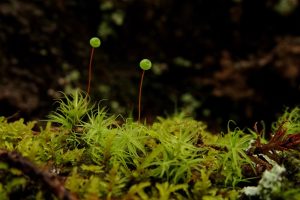 The universe is made up of very small things, but their stories can be very big. When we greet our tiny companions, zoom in on the microscopic, focus on the particulate – hidden worlds are revealed. Join us as we delve into the tales of small ecologies and discover their ripples into the wider ecosphere.
The universe is made up of very small things, but their stories can be very big. When we greet our tiny companions, zoom in on the microscopic, focus on the particulate – hidden worlds are revealed. Join us as we delve into the tales of small ecologies and discover their ripples into the wider ecosphere.
Every beam that fell on my face
Photons and waves
The paths that we’ve changed
They have all left a mark on this place
Inspirational materials
- Intimacy of Lichens (sound & film)
- Marine plastic debris photography, Mandy Barker
- flashing decaying wood, Alma Heikkilä (installation part of A Posthumous Journey into the Future at Uppsala Art Museum)
- Order and Chaos, Lady Maiser (song)
February 24 & March 10
Translating the Whales
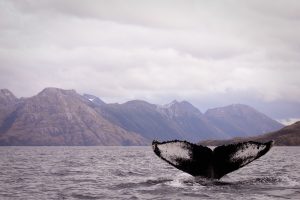
“I have a message… I was sent by the council of whales”
How we can listen to, understand, and translate the other beings that we share this planet with? Our watery kin, such as the magnificent whales, can seem so different from us small, two-legged, land-dwelling humans – yet like us they sing songs, have accents, memories, families. What would it mean to translate the voices of the more-than-human, especially those that live below the water, so that we can hear what they have to say too?
Quote: Lemn Sissay, ‘Whale Translation’
Inspirational materials
- Whale Translation – Lemn Sissay (poem) (video of poet reading)
- What the Whales Hear with Dr Kate Stafford – For the Wild (podcast)
- Lunasea – Mandy Barker (visual art)
- Tied to Tide – Turpin Crawford Studio (installation)
January 27 & February 10
Through Other Eyes
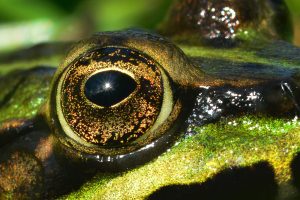 ‘From my point of view’… has a lot of hidden implications. We think as individuals before all else. We use our own culture as a standard to which we hold others. We centre ourselves, humans. But what if we saw the world differently? This month, we encourage you to use art as a lens to imagine an escape from egocentric, ethnocentric and anthropocentric worldviews.
‘From my point of view’… has a lot of hidden implications. We think as individuals before all else. We use our own culture as a standard to which we hold others. We centre ourselves, humans. But what if we saw the world differently? This month, we encourage you to use art as a lens to imagine an escape from egocentric, ethnocentric and anthropocentric worldviews.
Inspirational materials:
- superioryouareinferior by Rae spoon (music album, link to Spotify)
- Algal Blooms by Jade Cuttle (music album)
- Song for the Salmon by David Whyte (poem)
December 9 & January 13
heARTh, heART, eARTh
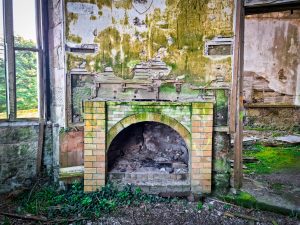
The interconnected concepts of hearth, heart, earth, and the art imbedded within all of them.
HEARTH: a fireplace we gather around, the feeling of home, a vital or creative centre
HEART: the (emotional) centre of us, the most vital part of something.
EARTH: the planet on which we love, the soil which gives us life and to which we will return.
Inspirational materials on the theme:
- Photography from Arno Rafael Minkkinnen, who uses his body to become part of the earth around him.
- Short film, Landing, exploring our role in our earth home.
- Construction art project Raising from Tessa Lynch with Jupiter Artland.
- Mother Earth: Works for Viola and Piano
November 11
Art from Trash: turning the wasted and unwanted into something new
